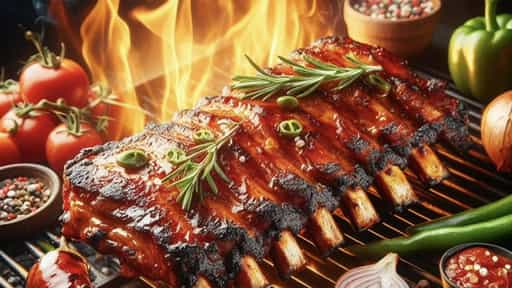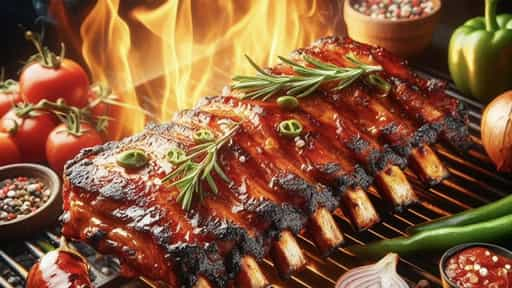
When it comes to ribs, tenderness is everything. You know those ribs that practically melt in your mouth? That’s what we’re aiming for here. The juicier and more succulent, the better.
First, let’s clarify the different types of ribs. We have spare ribs, baby back ribs, and St. Louis-style ribs, just to name a few. Each type has its unique features and flavour profiles. Spare ribs, for example, are meatier and usually more flavourful because of their higher fat content. Baby back ribs are leaner and tend to cook faster, while St. Louis-style ribs are trimmed spare ribs, offering a neat compromise between the two.
There’s a lot of misleading info out there about cooking ribs. Some people think you need a smoker or specialized equipment to get the best results, but that’s not true. You can achieve fantastic ribs with a regular oven, a grill, or even a slow cooker. It’s all about understanding the basics and applying them correctly.
Remember, the first step in mastering tender ribs is selecting the right type of rib for your taste and cooking method. We’re diving deep into how to make your ribs the best they can be, so stick around and let’s get those ribs perfectly tender and packed with flavor!
What Makes Spare Ribs More Tender and Flavourful?
Spare ribs owe their tenderness and rich flavor to a few key factors. One significant factor is fat marbling. The fat melts during cooking, which bastes the meat from the inside and keeps it moist. Extra fat means extra flavour and extra tender ribs.
Another big player is the cooking method. Different methods, like smoking, grilling, or oven roasting, impact the ribs’ texture. For instance, smoking infuses a deep flavour but requires a longer cook time. On the other hand, oven roasting can be more controlled and still deliver amazing results if done right.
Preparation and seasoning are crucial. Rubbing the ribs with a blend of spices, or marinating them for several hours, allows the flavours to penetrate deeply. A good rub or marinade balances sweet, salty, and spicy elements, enhancing the meat’s natural taste while tenderizing it.
Don’t forget the importance of removing the membrane from the underside of the ribs. It’s a thin, tough layer that can block flavours and keep the meat from becoming as tender as it could be. Taking a few minutes to get rid of it makes a world of difference.
When it comes to seasoning, think beyond the basics. Experiment with different spice blends and marinade ingredients like citrus juices, soy sauce, or even cola. These unique flavours can break down the muscle fibers, making the ribs even more tender and delicious.
Proven Techniques to Make Juicy, Tender Ribs
Low and slow is the mantra for tender ribs. Cooking your ribs at a low temperature for a longer period lets the collagen in the meat break down completely, which creates that melt-in-your-mouth texture. Whether you choose to grill, bake or smoke, patience here pays off big time.
Marinades and rubs are game-changers. A good marinade—think citrus juices, vinegar, or even beer—can start breaking down the meat fibers before cooking even begins. Dry rubs, packed with sugar, salt, and spices, build a flavorful crust that seals in the juices during cooking.
Your choice of equipment also matters. If you’re grilling, consider using a smoker box to give your ribs that smoky flavour without needing a full-on smoker. Oven-baking? Lay your ribs on a rack so air circulates all around them. Slow cookers can also work wonders for busy folks, making sure the meat stays tender and moist throughout.
Balancing the heat is key. Too much heat too quickly will toughen the meat while a slow, consistent temperature keeps it tender. If you’re grilling, use indirect heat. If you’re oven-baking, a low temperature around 275°F (135C) works wonders.
Don’t skip the rest period. After cooking, let your ribs rest for at least 10-15 minutes. This helps the juices redistribute throughout the meat, giving you a juicier bite and a better overall texture.
Keeping Ribs Moist and Tender Throughout the Cooking Process
Foil is your friend. Wrapping your ribs in foil partway through cooking traps the steam and juices, creating a super-tender texture. This method, known as the “Texas Crutch,” is a favorite among pitmasters and works beautifully whether you’re grilling or baking.
Basting and mop sauces can add a layer of moisture and flavour during the cooking process. These sauces, applied with a brush or mop, usually contain a mix of flavorful liquids like vinegar, beer, or a bit of your favourite barbecue sauce. Reapplying every 30 minutes or so ensures your ribs stay moist and flavorful.
Consistent cooking temperature is essential. Fluctuating temperatures can dry out the meat. If you’re using a grill, keep an eye on the heat and adjust the vents as needed. With an oven, use an oven thermometer to ensure it’s maintaining the right temperature. Keeping it steady around the 275°F (135C) mark ensures a slow rendering of fat and tender meat.
Avoid over-cooking. While low and slow is key, too much time can indeed dry out the ribs. Start checking for doneness around the 4-hour mark if you’re cooking at a low temperature. The meat should pull away from the bones with just a slight tug, not fall off completely.
Consider a water pan if you’re using a smoker or grill. Placing a pan of water underneath the ribs adds moisture to the air inside, helping to keep the meat moist and tender. It’s a small step that can make a big difference.
Expert Tips and Tricks for the Best Ribs
Quality meat makes a noticeable difference. Opt for fresh, well-marbled ribs from a trusted source. The better the meat, the easier it is to achieve that tender, flavourful outcome.
Resting is often overlooked but super important. After cooking, let your ribs rest under a loose foil tent for 10-15 minutes. This gives the juices time to redistribute throughout the meat, providing a juicier bite.
One common pitfall is skimping on seasoning. Don’t be afraid to generously season your ribs with rubs or marinades. This deepens the flavor and helps tenderize the meat during cooking.
Making sure not to rush things is key. If you’re in a hurry, ribs might not be the best choice. Giving them the time they need is essential for achieving that perfect tenderness.
Avoid peeking or opening the grill or oven too often. Each time you do, heat escapes, and it disrupts the consistent cooking environment. Trust the process and let the ribs cook uninterrupted as much as possible.

